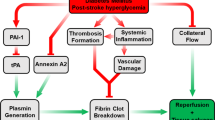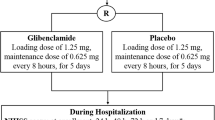Abstract
The SUR1-TRPM4 channel is a critical determinant of edema and hemorrhagic transformation after focal ischemia. Blockade of this channel by the small molecule glyburide results in improved survival and neurological outcome in multiple preclinical models of ischemic stroke. A robust, compelling body of evidence suggests that an intravenous formulation of glyburide, RP-1127, can prevent swelling and improve outcome in patients with stroke. Retrospective studies of diabetic stroke patients show improved outcomes in patients who are continued on sulfonylureas after stroke onset. An early phase II study using magnetic resonance imaging and plasma biomarkers supports the conclusion that RP-1127 may decrease swelling and hemorrhagic transformation. Finally, the ongoing phase II RP-1127 development program has demonstrated continued safety as well as feasibility of enrollment and tolerability of the intervention. Continued efforts to complete the ongoing phase II study and definitive efficacy studies are needed to bring a candidate pharmacotherapy to a population of severe stroke patients that currently have no alternative.
Access this chapter
Tax calculation will be finalised at checkout
Purchases are for personal use only
Similar content being viewed by others

References
Jauch EC, Saver JL, Adams HP Jr et al (2013) Guidelines for the early management of patients with acute ischemic stroke: a guideline for healthcare professionals from the American Heart Association/American Stroke Association. Stroke 44(3):870–947. doi:10.1161/STR.0b013e318284056a
Hacke W, Schwab S, Horn M, Spranger M, De Georgia M, von Kummer R (1996) ‘Malignant’ middle cerebral artery territory infarction: clinical course and prognostic signs. Arch Neurol 53(4):309–315
Wijdicks EF, Sheth KN, Carter BS et al (2014) Recommendations for the management of cerebral and cerebellar infarction with swelling: a statement for healthcare professionals from the American Heart Association/American Stroke Association. Stroke 45(4):1222–1238. doi:10.1161/01.str.0000441965.15164.d6
Broderick JP, Palesch YY, Demchuk AM et al (2013) Endovascular therapy after intravenous t-PA versus t-PA alone for stroke. N Engl J Med 368(10):893–903. doi:10.1056/NEJMoa1214300
Mlynash M, Lansberg MG, Straka M et al (2011) Refining the definition of the malignant profile: insights from the DEFUSE-EPITHET pooled data set. DEFUSE-EPITHET Investigators. Stroke 42(5):1270–1275. doi:10.1161/STROKEAHA.110.601609. [Epub 2011 Apr 7]
Molina CA, Selim MH (2011) Decompressive hemicraniectomy in elderly patients with malignant hemispheric infarction: open questions remain beyond DESTINY. Stroke 42(3):847–848. doi:10.1161/STROKEAHA.110.603613
Juttler E, Bosel J, Amiri H et al (2011) DESTINY II: DEcompressive surgery for the treatment of malignant INfarction of the middle cerebral arterY II. Int J Stroke 6(1):79–86. doi:10.1111/j.1747-4949.2010.00544.x
Sheth KN (2013) Novel approaches to the primary prevention of edema after ischemia. Stroke 44(6 Suppl 1):S136. doi:10.1161/STROKEAHA.113.001821
Simard JM, Chen M, Tarasov KV et al (2006) Newly expressed SUR1-regulated NC(ca-ATP) channel mediates cerebral edema after ischemic stroke. Nat Med 12(4):433–440. doi:10.1038/nm1390
Simard JM, Tsymbalyuk N, Tsymbalyuk O, Ivanova S, Yurovsky V, Gerzanich V (2010) Glibenclamide is superior to decompressive craniectomy in a rat model of malignant stroke. Stroke 41(3):531–537. doi:10.1161/STROKEAHA.109.572644
Simard JM, Sheth KN, Kimberly WT et al (2013) Glibenclamide in cerebral ischemia and stroke. Neurocrit Care. doi:10.1007/s12028-013-9923-1
Fisher M, Feuerstein G, Howells DW et al (2009) Update of the stroke therapy academic industry roundtable preclinical recommendations. Stroke 40(6):2244–2250. doi:10.1161/STROKEAHA.108.541128
Simard JM, Kent TA, Kunte H (2011) Letter by Simard et al regarding article, “Sulfonylurea use before stroke does not influence outcome”. Stroke. doi:10.1161/STROKEAHA.111.620666
Favilla CG, Mullen MT, Ali M, Higgins P, Kasner SE, Virtual International Stroke Trials Archive (VISTA) Collaboration (2011) Sulfonylurea use before stroke does not influence outcome. Stroke 42(3):710–715. doi:10.1161/STROKEAHA.110.599274
Horsdal HT, Mehnert F, Rungby J, Johnsen SP (2012) Type of preadmission antidiabetic treatment and outcome among patients with ischemic stroke: a nationwide follow-up study. J Stroke Cerebrovasc Dis 21(8):717–725. doi:10.1016/j.jstrokecerebrovasdis.2011.03.007
Kunte H, Schmidt S, Eliasziw M et al (2007) Sulfonylureas improve outcome in patients with type 2 diabetes and acute ischemic stroke. Stroke 38(9):2526–2530. doi:10.1161/STROKEAHA.107.482216
Kunte H, Busch M, Trostdorf K et al (2012) Hemorrhagic transformation of ischemic stroke in diabetics on sulfonylureas. Ann Neurol 72:799–806
Mehta RI, Ivanova S, Tosun C, Castellani RJ, Gerzanich V, Simard JM (2013) Sulfonylurea receptor 1 expression in human cerebral infarcts. J Neuropathol Exp Neurol 72(9):871–883. doi:10.1097/NEN.0b013e3182a32e40
Sheth KN, Taylor Kimberly W, Elm JJ et al (2014) Exploratory analysis of glyburide as a novel therapy for preventing brain swelling. Neurocrit Care 21(1):43–51. doi:10.1007/s12028-014-9970-2
Sheth KN, Kimberly WT, Elm JJ et al (2013) Pilot study of intravenous glyburide in patients with a large ischemic stroke. Stroke. doi:10.1161/STROKEAHA.113.003352
Thomalla G, Hartmann F, Juettler E et al (2010) Prediction of malignant middle cerebral artery infarction by magnetic resonance imaging within 6 hours of symptom onset: a prospective multicenter observational study. Ann Neurol 68(4):435–445. doi:10.1002/ana.22125
Yoo AJ, Sheth KN, Kimberly WT et al (2012) Validating imaging biomarkers of cerebral edema in patients with severe ischemic stroke. J Stroke Cerebrovasc Dis. doi:10.1016/j.jstrokecerebrovasdis.2012.01.002
Davis SM, Donnan GA, Parsons MW et al (2008) Effects of alteplase beyond 3 h after stroke in the echoplanar imaging thrombolytic evaluation trial (EPITHET): a placebo-controlled randomised trial. Lancet Neurol 7(4):299–309. doi:10.1016/S1474-4422(08)70044-9
Todd NV, Picozzi P, Crockard A, Russell RW (1986) Duration of ischemia influences the development and resolution of ischemic brain edema. Stroke 17(3):466–471
Schaefer PW (2000) Diffusion-weighted imaging as a problem-solving tool in the evaluation of patients with acute strokelike syndromes. Top Magn Reson Imaging 11(5):300–309
Jha R, Battey TW, Pham L et al (2014) Fluid-attenuated inversion recovery hyperintensity correlates with matrix metalloproteinase-9 level and hemorrhagic transformation in acute ischemic stroke. Stroke 45(4):1040–1045. doi:10.1161/STROKEAHA.113.004627
Castellanos M, Leira R, Serena J et al (2003) Plasma metalloproteinase-9 concentration predicts hemorrhagic transformation in acute ischemic stroke. Stroke 34(1):40–46
Kimberly WT, Battey TW, Pham L et al (2013) Glyburide is associated with attenuated vasogenic edema in stroke patients. Neurocrit Care. doi:10.1007/s12028-013-9917-z
Kimberly WT, Sheth KN (2011) Approach to severe hemispheric stroke. Neurology 76(7 Suppl 2):S50–S56. doi:10.1212/WNL.0b013e31820c35f4
Simard JM, Sahuquillo J, Sheth KN, Kahle KT, Walcott BP (2011) Managing malignant cerebral infarction. Curr Treat Options Neurol 13(2):217–229. doi:10.1007/s11940-010-0110-9
Author information
Authors and Affiliations
Corresponding author
Editor information
Editors and Affiliations
Rights and permissions
Copyright information
© 2016 Springer International Publishing Switzerland
About this chapter
Cite this chapter
Sheth, K.N., Simard, J.M., Elm, J., Kronenberg, G., Kunte, H., Kimberly, W.T. (2016). Human Data Supporting Glyburide in Ischemic Stroke. In: Applegate, R., Chen, G., Feng, H., Zhang, J. (eds) Brain Edema XVI. Acta Neurochirurgica Supplement, vol 121. Springer, Cham. https://doi.org/10.1007/978-3-319-18497-5_3
Download citation
DOI: https://doi.org/10.1007/978-3-319-18497-5_3
Publisher Name: Springer, Cham
Print ISBN: 978-3-319-18496-8
Online ISBN: 978-3-319-18497-5
eBook Packages: MedicineMedicine (R0)



